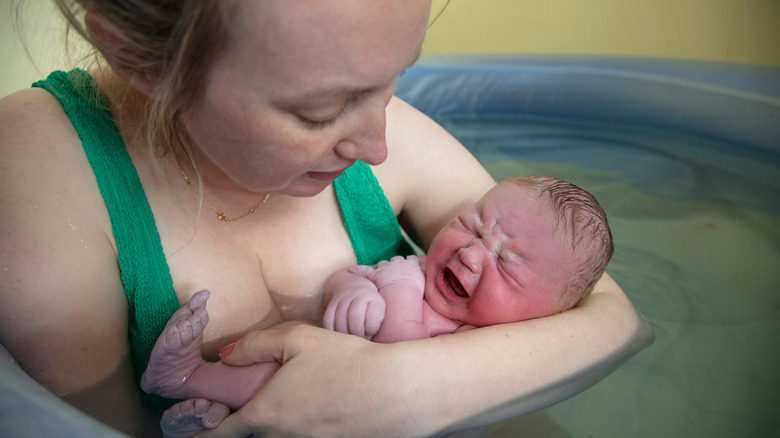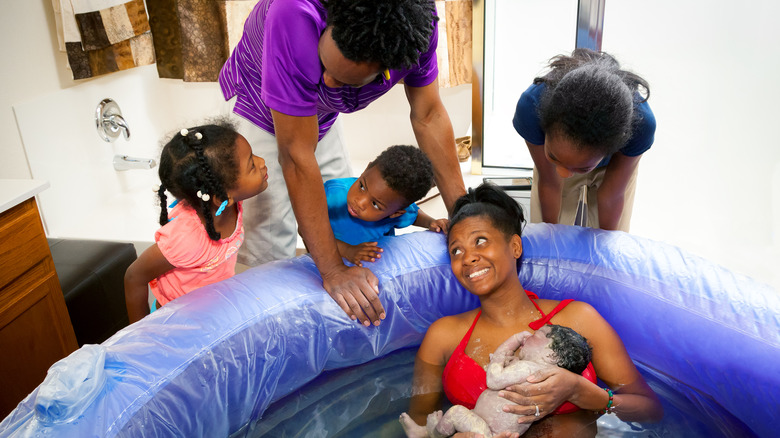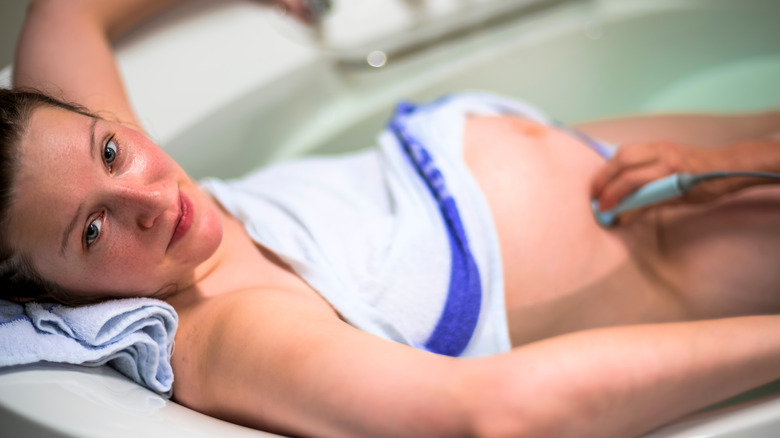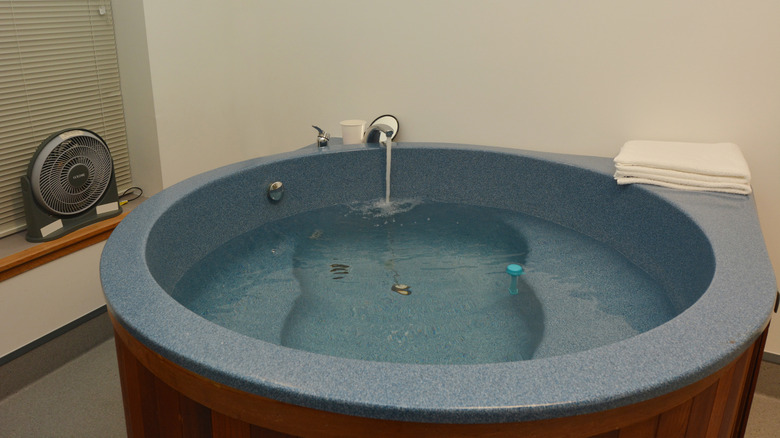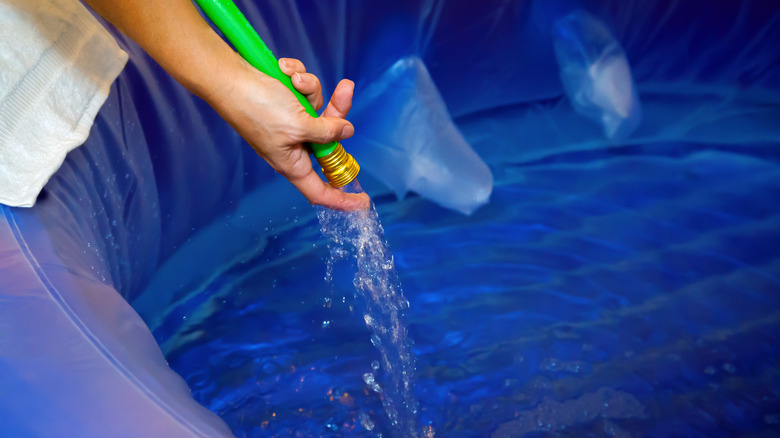Everything You Need To Know About Water Births
Nowadays, pregnant women have various options when it comes to the location and the way they give birth, as per Parents. Women no longer have to labor and give birth on their backs in a hospital bed, unless this is deemed medically necessary. Many forgo the hospital setting altogether and greet their babies in the comfort of their own homes or in a birth center, which is a hybrid between a hospital and home environment, as explained by the American Association of Birth Centers.
Within the aforementioned environments, anyone experiencing an uncomplicated pregnancy — meaning there are no issues with preeclampsia, the fetus has reached 37 weeks of gestation, and the baby is positioned with its head down — may have the option to choose a water birth (per Parents). This essentially means that the woman labors and gives birth while submerged in some sort of aquatic environment, whether it be a bathtub or an inflatable pool specifically designed for this purpose.
Water births aren't new — they've been around since the early 1800s, but they didn't start becoming popular until the 1980s and 1990s (per Evidence Based Birth). However, researchers have only more recently begun studying the safety of water births. As a result, there are plenty of misconceptions that circulate about water births — including whether they are safe — and the accompanying risks and benefits. We've gathered the answers to all your questions about water births below.
Water births are relatively safe
The American College of Nurse-Midwives (ACNM) released a statement in 2014 regarding the safety of water-based births. Its position is as follows: "Women should be given the opportunity to remain immersed during labor and birth if they wish to do so within the context of a shared decision-making process with their health care providers. This process includes ongoing maternal and fetal assessment as labor progresses." While they recognized that research on water births is somewhat limited, they did note that the existing research points to similar maternal and neonatal outcomes between water and land births.
A later 2019 study published in Birth confirmed the safety of water births after comparing 397 water births and 2,025 land births. The researchers did not find an increased risk of harm to babies born in water nor was there a greater possibility of postpartum hemorrhage and perineal lacerations. In fact, the study showed that "fewer women in the waterbirth group sustained first- or second-degree lacerations requiring sutures."
That being said, there are some precautions to take when giving birth in water. WebMD explains that anyone pursuing this type of birth should be accompanied by an experienced and licensed healthcare professional. Additionally, the tub or pool should be properly disinfected and the water should be kept at an appropriate temperature. Finally, it's important that regular fetal monitoring continues to take place throughout labor and birth.
There are risks associated with a water birth
If you choose a water birth, it's important to go into it well-informed. This includes being aware of the risks and complications associated with the process. Oregon Health & Science University's Center for Women's Health points out that one risk of having a water birth is if the baby tries to take their first breath while still underwater. While this is rare since a baby typically only instinctively begins breathing once they feel the air on their face, it can happen if the pelvis and hips aren't fully submerged in the water when the baby's head emerges.
The Center for Women's Health explains that an additional complication associated with water births is the risk of infection. Germs can leave the woman's body through feces and blood and end up in the water before getting passed along to the baby. That being said, a 2005 study published in The Journal of Maternal-Fetal & Neonatal Medicine found that as long as proper hygiene and sterilization procedures are followed, there is not a higher risk of infection.
One more risk of opting for a water birth is that the umbilical cord could tear if it is too short when the baby is brought up to the surface following birth, as per Parents. "A snapped umbilical cord can be life-threatening, as the fetus can bleed freely until it is stopped," OB-GYN Dr. Patrick Weix told Parents. Clamping the cord can eliminate this issue, however.
Water births have benefits for both mother and baby
The American College of Obstetricians and Gynecologists (ACOG) outlines a number of benefits associated with giving birth in an aquatic environment. Among them is the potential for a shorter overall labor time and a decreased need for pain-relieving interventions, such as an epidural.
In a 2014 study published in BMC Pregnancy and Childbirth, researchers also discovered that labor pain was reduced during water births. Additionally, they found that water births were associated with a lower cesarean section rate when compared to land births. Finally, those who gave birth in water reported less stress incontinence 42 days after delivery, which is when a physical movement or activity, such as sneezing or jumping, leads to accidental bladder leakage (per the Mayo Clinic).
The American Pregnancy Association outlines several more benefits of water births. For starters, the warm water itself is beneficial to a woman in labor by providing a relaxing and comforting environment. The buoyancy of the water makes for more efficient uterine contractions while improving blood circulation throughout the woman's entire body, in turn supplying more oxygen to the baby. Giving birth in water can also reduce the risk of perineal tearing by making the area softer and more elastic. Finally, the baby also benefits from making their entrance into the world in this way: the transition from the environment of the amniotic sac is less abrupt and they experience less stress during delivery.
Water births aren't appropriate for everyone
It's important to note that water birth is not adequate nor recommended for every delivery. Gynecologist Marra Francis outlines a number of conditions that would make a water birth unsafe, including "Group B Strep positive cultures, gestational diabetes, preeclampsia, macrosomia, intrauterine growth restriction, prematurity, and an unproven pelvis" (via Parents). "High-risk conditions or complications in labor often necessitate continuous fetal monitoring or immediate intervention, which is better accomplished outside of the water," OB-GYN Dr. Edwin Huang told Parents.
WebMD lists a few other factors that would make a land birth a better choice. Firstly, anyone having more than one baby is advised to avoid water births. Additionally, the pregnant woman should be no younger than 17 and no older than 35. If the baby is measuring large for their gestational age, it is also recommended to opt for a land birth.
There are certain conditions that must be met in order for a water birth to be deemed appropriate (per Parents). These include having low blood pressure, reaching 37 weeks gestation, and presenting a non-breech baby (meaning the baby's head is pointed down in the proper birthing position). That being said, if you don't meet these conditions and still want to consider a water birth, you should discuss your needs and individual risks with your healthcare professional to determine the best course of action.
Water births typically incur extra fees
The cost of a water birth will depend on the location you give birth, as explained by Healthline. For example, if you will be giving birth in a hospital or birth center that offers a water birth option, this may already be covered within the fees of a general vaginal birth. The cost of a vaginal birth without insurance in the United States can range anywhere from $5,000-10,000.
Homebirths, on the other hand, are typically paid out of pocket and hover in the $1,500-5,000 range (per Healthline). Whether or not a birthing pool is covered in this cost depends on an individual midwife's services. You also have the option to buy or rent a birthing tub yourself, which will set you back about $300. That being said, Waterbirth International states that some insurance companies will reimburse the cost of a birthing tub when used for pain management.
In addition to the cost of the birth and the tub, there are additional supplies you will need to procure for a successful water birth if you opt to deliver your baby in your home (via Healthline). These include a hose for filling the tub, a tarp to lay underneath the tub in the case of spillage, towels, a thermometer for the water, Epsom salts, a pool liner, and cleaning supplies. In the case of a home water birth, it's always best to consult your midwife for a full list of necessary items.

